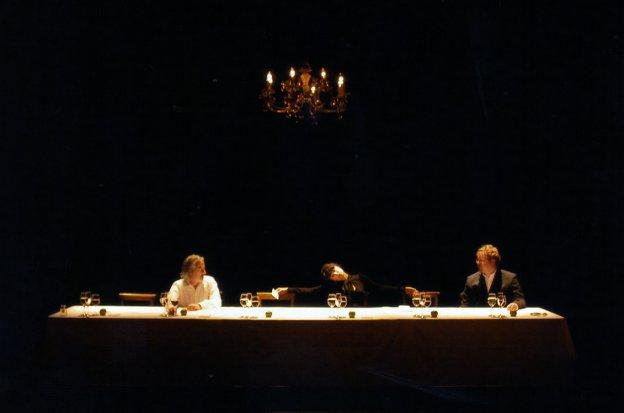Reckless Sleepers reopen a world within a world: presented before us is a restaging/reimagining of their 1998 work, Schrödinger. A large black box consumes the stage. One side is open to the audience allowing us to see inside of this monolithic structure filling the main theatre of the Arnolfini. It shows the hallmarks of use and is made up of numerous hatches and doors. This is a place in which paradoxical imaginings coexist in time and space.
With frenetic energy five performers are consumed in their relentless and unforgiving task of testing the environment that they exist in. They are figures at the end of their tether, caught in a cycle of exploration that requires them to engage, through movement and scripted passages, with Erwin Schrödinger’s 1933 quantum theory – which states that at an atomic level particles of light may exist in a single moment both in a state of decay and not; and that a box in theory may therefore hold both life and death for a single entity in a simultaneous instance. For Reckless Sleepers, Schrödinger is about the immeasurable experiment: a series of contradictions placed alongside one another in an attempt to wrestle truth from juxtaposition. But is there a truth to be found? By its own cyclical nature, nothing can be resolved here; what little truth exists can only be found in the erratic live struggle to break free from the confines of the experiment.
Within this however there is something that sits uncomfortably in viewing the work. We are told at the outset that, ‘It may seem to you that we’ve done this for the first time, but even the mistakes have been repeated over and over to get them exactly right… Nothing is left to chance; nothing can go wrong, we’ve thought of every eventuality.’ Which in turn leads the work to hold a rigid, almost lifeless quality under the fixed choreography of the cast. The spoken dialogue appears numb and there is a sense of misjudged acting in what should be real action. The work is extremely theatrical and in a post-show discussion the artistic director, Mole Wetherell, celebrates the piece as theatre but then speaks of its realness as if it were more akin to performance art and follows through with a commentary on his unforgiving feelings towards the contrivances of traditional theatre. But as in the performance there is a duplicity at play. What takes place is an experiment – the acted and choreographed contrivances aren’t a failure but a necessary force as the work thrives on its ability to contradict itself. The performers fight against their self-imposed limitations creating a duplicitous commentary that not only examines the lifelessness found in this purgatory but also the vitality in the act of reenacting an act of making.
Despite what we may be told, within this space mistakes can be made, unique moments do explode – it’s impossible for them not to. The living entity of the human form is by nature imprecise and in the chaotic cacophony of bodies, water, chalked scrawling, fighting tables and mess comes real fraught anxiety and misplaced figures. Moments that see performers fight to scrawl words in chalk that others wash away, or outstretched hands misplaced to be marked with chalked crosses, or apples rolling away from where they are meant to be, are unrepeatably unique and seek to engage under the hegemonic sense of the coldly regimented. Schrödinger is an experiment in truth and lying; it is filled with glorious moments and tedious predictability. It engages and disenchants; on one level it is the best piece of action you may see in sometime, and on the other the worst example of theatre filled with dire drained acting.
Actors fall through hatches from the ceiling, riff on themes of alcohol consumption, cats, mountains and waves of light. Bodies are thrown around the space and the majesty of the box is defaced in elegantly haphazard chalk scrawlings. After watching, it will leave you to wrestle with its problems and anxiety for days to come, which in many ways is where it really excites. The people at play in this world are like mice in a science experiment; they are forced to behave, to repeat and yet fight against this. The work is an unending battle for its participants but the central figure is the box; the closing image of which leaves its occupants wretched and used. The climatic finale is beautiful as soaked, shattered bodies litter the space of the cube; the sixth and most central character that has dominated all, now revealed as a living entity in its own right, stood before us covered in chalk handwriting and doodles, crying as water cascades feebly from every worn and tired orifice. We leave this world exhausted and frustrated. Knowing it is set to endlessly repeat we understand the drain it has had on its occupants; like the particles in a single moment they are stuck both vibrantly alive and dead. The box owns space, time and is a world of truth trapped in a blanket of lies.


